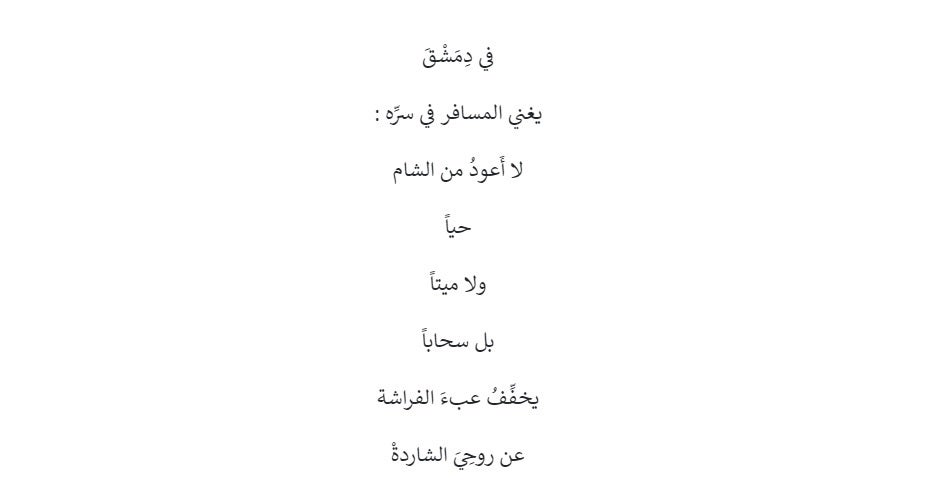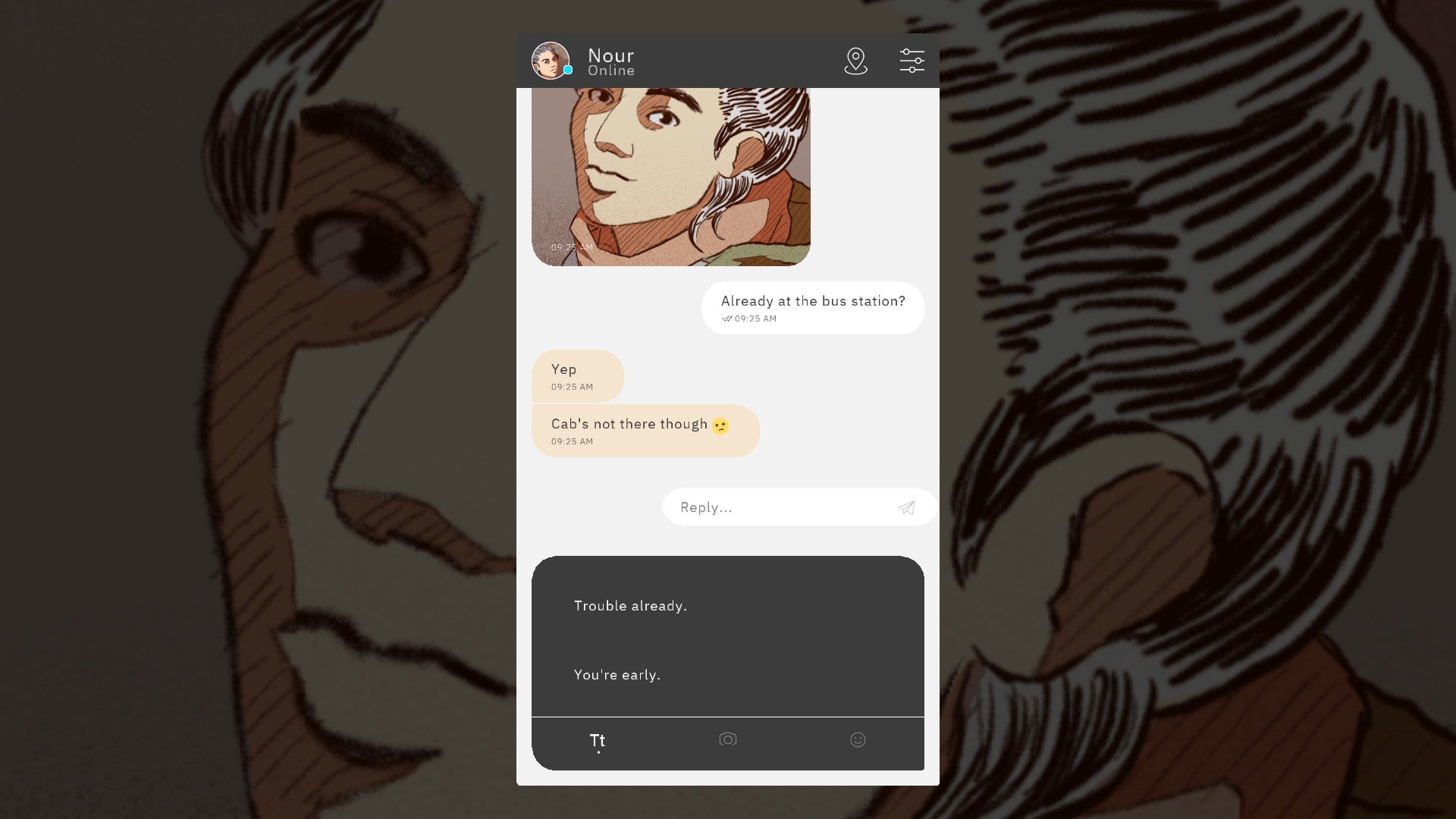the traveller sings in his heart: I return from Syria neither as living nor as dead but as a scudding cloud that lightens the butterfly’s burden upon my uprooted soul’ At the antipodes of taste and good judgement lie the responses of the Parisian Institut du Monde Arabe (IMA) and of Russian indie developers Cats Who Play. The former has used the Steam platform to freely distribute a virtual reality art installation created by Ubisoft as part of the 2018 exhibition Cités Millénaires as Age-Old Cities VR. Donning their Vive, Oculus, or Index goggles, the ‘player’ finds themselves transported to life-size reproductions of Middle Eastern locations of exceptional cultural and archaeological significance. Two are in Syria: the ancient temple of Canaanite sky-god Baalshamin at Palmyra (Tadmur) and the endless warrens of Aleppo’s great souq. The former was vandalised by the so-called Islamic State in 2015, while the latter has suffered terribly from the depredations of the civil war. Meanwhile, the Russian indie RTS entitled Syrian Warfare advertises its ‘high degree of realism’ and features unlockable Achievements including ‘Instant Karma’, ‘Death Road’, and ‘Payback’. Both products wear their engagement on their sleeves. Both present themselves as informing the player about the real world, about real events and real places. About Syria. They do not simply take unreflective part in a political fantasy, as do the endless examples of unthinkingly Americentric, chauvinistic, and militaristic tropes in other games. They seek actively to change minds. To educate, to inform, and to influence for the better. They appeal to cosmopolitan virtues of solidarity and global citizenship. Consume us, they promise, and you can better understand Syria. Consume us, and make the world a better place. Whether this promise is credible or not, both experiences do share an aspiration to informing global consciousness. Both also share a marked absence. They are hauntingly empty of plausibly human beings. The IMA’s architectural installation encourages respect, reverence, and protection of some of the crown jewels of Mediterranean civilisation. Shuttered shopfronts hint at the life that once thrummed through them, but are now as still as the crumbling Byzantine facades of the Dead Cities that dot ancient Aleppo’s grassy hinterland. Age-old edifices are left to speak, however eloquently, for themselves. Syrian Warfare, meanwhile, ventriloquises its miniscule combatants only to issue polemical pretexts for gameplay violence. Wicked White Helmets gleefully fake atrocities, colluding with lying Western journalists to smear the noble state. The protagonist dismisses his family in the prologue with a curt ‘Quiet, woman! Do as I say!’, and they are never heard from again. ‘What kind of Arab would I be if I didn’t have a RPG buried in my yard!’ remarks another of its crudely racialised caricatures. What kind, indeed. Both digital responses to the Syrian crisis - so utterly different in sophistication, tenor, and intent - dehumanise their subjects in precisely the way the melancholy poet does not. The personal dimensions of Syrians’ interlocking crises are better explored by the BAFTA-nominated Bury Me My Love: a branching narrative told through a conversation between Nour, who has fled the country, and her partner Majd, who remains behind. Yet here too, games struggle with the task of communicating the subject to the audience. This is not only a challenge of all fiction - that we do not always respond to fictional characters the way we do to living beings (hence the appeal of the picaresque, the anti-hero, the flamboyant villain - of Harry Flashman and Milton’s Satan, of Waluigi and of Kefka). Games distinguish themselves from other media not least in their concern for agency. They are always interactive, and the player’s choices matter - even if only to decide whether Mario falls in a pit or vaults over it. As a result, Bury Me My Love boasts that Nour is ‘able to visit 50 different locations and reach 19 potentially different endings’. This surely makes it a better game. But it also elides realities of forced displacement: less an adventure of ever-opening horizons and fresh challenges to be overcome than a constricting tangle of coercion and disruption, of abrupt and incomprehensible dead-ends. Real life is choked by exorbitant paywalls and littered with interminably and inexplicably un-skippable cut-scenes. It does not always respect our agency or value our time. Shigeru Miyamoto could not have designed a border crossing, a refugee camp, a workhouse. Eurogamer would not Recommend a trek for asylum across Anatolia. And the designers of Bury Me My Love would hardly wish to imply that Syrian children drowning in the Adriatic are victims only of their own poor choices, some personal failure to git gud at the game of life. This is not just the awkward ’ludonarrative dissonance’ of ostensibly virtuous avatars blithely gunning down waves of dehumanised villains. It betokens a deeper chasm between medium and message. What if a game really were capable of abandoning or reimagining player agency and reliably reproducing the gnawing worry, the betrayed hopes, the howling grief, and the leaden tedium of lived sufferings? Would that best help us to understand the real Nours, the real Majds? It is far from clear that it would. This is not only true because suffering freely chosen is not the same as suffering imposed upon one. Still less is it true that human beings simply cannot truly imagine the experience of another without undergoing it for themselves. It is rather because those who suffer tragedy are so much more than their suffering. It is precisely that more which makes their suffering tragic. We are bereaved by the loss of those close to us precisely because we have such long and so deep an experience of the lives they lived: their thoughts, their habits, their creations, the hopes they cherished. Talk at wakes and funerals turns on such themes, passing only lightly over the mundane grotesqueries of disease, death, and decay. This is not a form of denial. It is affirmation. Real solidarity calls us to know the dreams of the other, and not just their nightmares. This is something developers can perhaps learn from Mahmoud Darwish, the poet with whose verse we began. His poetry crosses boundaries of geography, religion, and politics precisely through its acutely personal lyricism. That butterfly’s burden of the exile, at once light and heavy, tracing Lorenzian loops around the strange attractor of a (perhaps) unreachable goal, weighs on his spirit. But it is not itself his spirit. The poet shares his living humanity, and we understand his exile only through it. He does not first describe his exile and then attempt to humanise it. His focus on the lived, the lyrical, the painfully beautiful is not denial but affirmation. Digital media which seek to cultivate empathy and fellow-feeling with the displaced people of Syria might be better served by exploring the moments and meanings which move us to more than pity. They might even strive, as fellow-exile Edward Said once wrote, ’to transform the lyrics of loss into the indefinitely postponed drama of return’.

